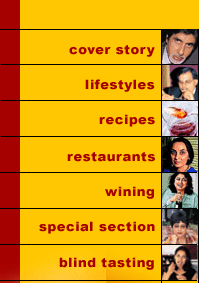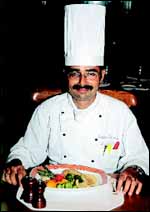



|
|
BANGLADESH is a nation of rice and curry eaters. Curry is a big thing with us. All kinds of curries. Especially fish, meat and chicken. Yes, even beef. It�s very popular. And duck, which is cooked in onion, coriander and turmeric and served with an excellent bhoona khickri. But unlike the fiery and pungent curries of North and South India, our curries don�t carry so much of a bite. They are mild and creamy, and often rather watery. Bangla curries go well with rice. We have no great culture of breads. No naans and parathas. That�s because rice is grown abundantly in Bangladesh. And it�s freely available to the rich and poor.
We make our curries without too much of reliance on herbs. Spices, yes. Certainly, ginger, garlic, turmeric and chilli are an absolute must in our masalas. But they complement the main ingredient of the recipe. Most any Bangla recipe you take up, you will find that we use these spices in a harmonious blend to produce the most delectable quormas, jhols (curries) and bhajees (frys). We even make a Mughlai do-piyaza with the kaschki fish for breakfast. It�s a very popular dish. People have the kaschki do-piyaza for lunch and dinner too.
One of the big differences between Bangla food and Calcutta�s, is the Mughlai influence. It is there in Calcutta, of course, but in a very small way. There are Mughlai eateries off Chowringhee Road, there is street food, but not like in Lucknow and Hyderabad. Or even New Delhi. Our Mughlai cuisine is very much like your Lucknowi food... but with the Bengali touch. Not just in its form of cooking, but in the presentation also. I think that is because there are families in Lucknow that are related to our Dhaka nawabs. We use chicken and beef in our Mughlai cooking too. That you will not find in India so much.
And there�s the fish! Certainly, our hilsa�s better any day. We get some great freshwater fish in Bangladesh, not just the hilsa. Look at the rivers that flow through the country. There�s the Padma, which is rich with hilsa, the Brahmaputra, Jamuna and Meghna, known for their pabda, pangash and rohu. We cook these fish with vegetables to make jhals and jhols. Snakegourd, okra, eggplant, tomato and potato go into recipes of pabda and pangash. The kaschki is also a territorial freshwater fish. We cook it dry. For the rohu, we borrow a recipe from the Bengali gharana of cooking. The rohu heads are cooked in a masala moong dal. Unfortunately, outsiders are often put off by fish heads in dal!
Prawns, lobster and crab are not so popular in Bangladesh. I would say of these, the lobster sells the most. It is cultivated. We have big lobster farms in Khulna district. The produce here is renowned. We, of course, do a malai chingree Bengali-style, using spicy coconut cream with freshwater prawns. And we put the golda chingree, that is your jumbo prawns, also into a do-piyaza with dry masalas and onions.
I�m constantly asked why the Bangladeshi hilsa is better than the Indian. We have not gone into research and details about this. Especially since the preparations are like in Calcutta, in a mustard gravy and spicy yogurt. But, I believe, it is because the waters of the Ganges that flow into Bangladesh and form the Padma River are far less polluted than the river waters in West Bengal. The feed is also better here. We have a strong monsoon, and heavy rains sweep much of the paddy from the fields into the rivers. The hilsa feeds on the paddy and gets fat. It is a very costly fish. Now more so, because we export the hilsa to the US and UK. It�s available in all the major shopping malls. We also export it to India. Your Jyoti Basu is more fond of the Bangla hilsa than the local!
Bangladeshi cuisine is slowly being recognised around the world, but it will take time to reach the level of Indian recognition. At one time in Europe, 80 per cent of the "Indian" restaurants were Bangladeshi! Europeans assumed that we were Indians, so we played along. At that time, nobody would have wanted to risk eating at a Bangla restaurant anyway. Now times have changed. There are Bangla restaurants all over South-East Asia. In Singapore, Bangkok, Malaysia. They are doing great business. Our chefs our doing a good job promoting our cuisine abroad.
There is going to come a time when Bangladesh will be recognised not just for its poets and artists, but also for its delectable cuisine. Within the country, too, there is a change, people have sort of imbibed this culture of eating out from India. Five years ago, there were just 30 restaurants in Dhaka. Today there are 165. These are mainly Chinese. But at least one new restaurant opens every week.
Thai, Japanese, Korean, Bukhara, these are the popular cuisines. But the best is, of course, Bangla food. When President Bill Clinton visited Bangladesh and came to the Dhaka Sheraton Hotel, I asked him what he wanted to eat. And he replied, "Your food!" I gave him patishapta, a Bangla desert of rice crepes filled with thickened milk that has been enriched with palm sugar. Did he like it? Ask him!
|

Home Page
About the mag
Subscribe
Advertise
Contact Us